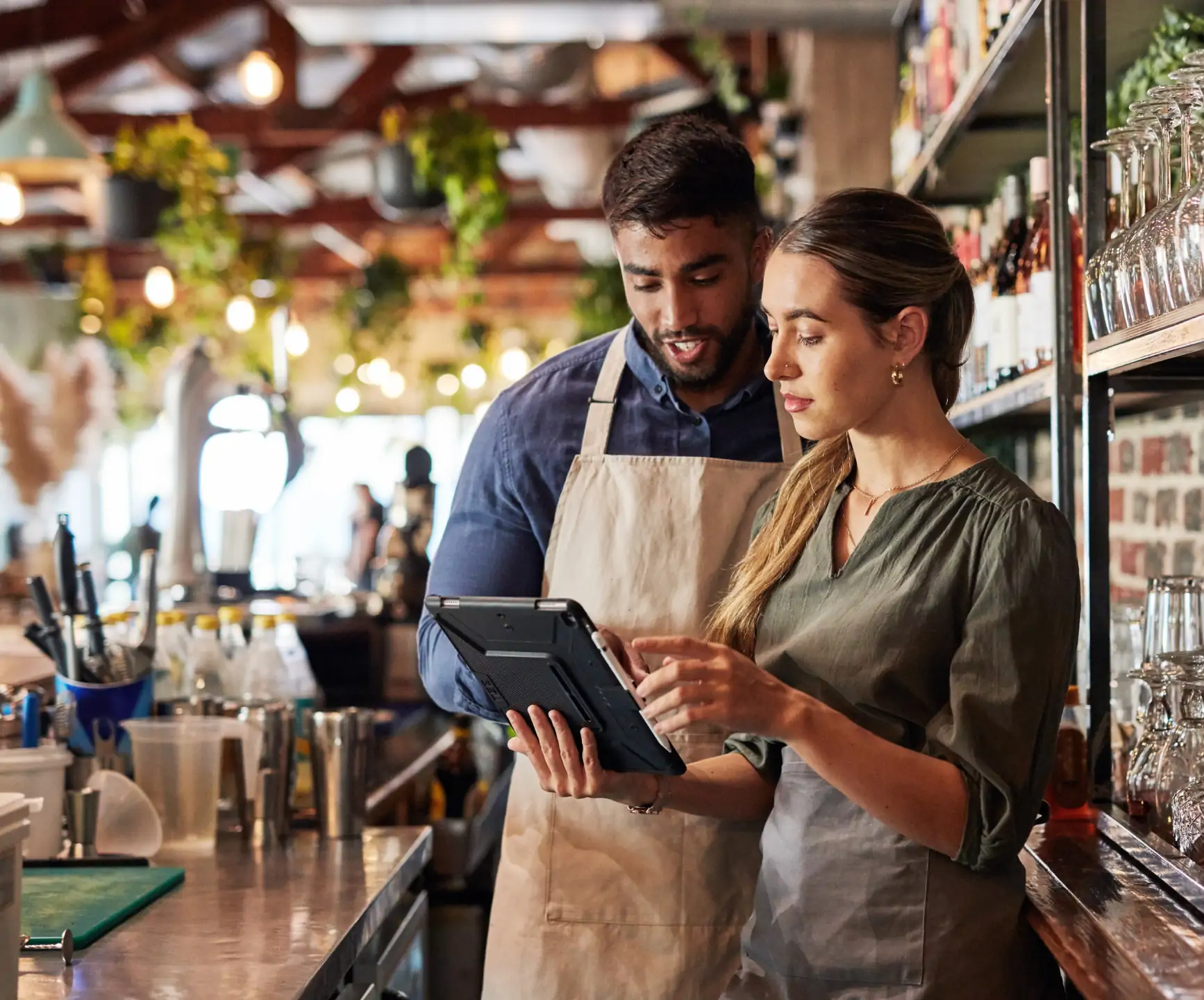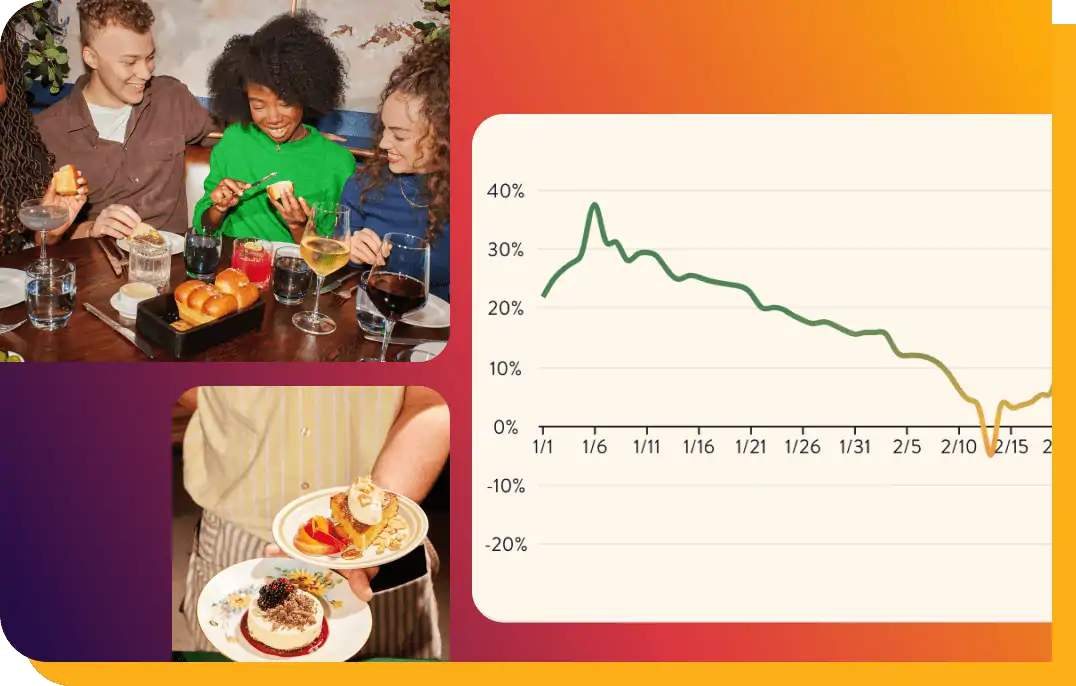From AI-powered reservation systems to contactless payment solutions, technology continues to shape how restaurants are run. Getting to grips with these emerging restaurant technology trends can elevate your spot as you embrace innovation and provide a standout experience to guests.
Here’s the current trends shaping the restaurant industry in 2025.
Why is restaurant technology so important?
Nobody got into restaurants for the love of spreadsheets. Technology removes those headaches from your plate so you can focus on creating memorable dining experiences. The right tools improve your revenue by turning tables faster while cutting food waste. Technology often leads to smarter decisions in an industry where margins are notoriously tight.
Guests expect convenience at every touchpoint, from browsing your menu online to paying without waiting for a server. Restaurants that make the experience frictionless tend to win loyal diners, while those still relying heavily on manual processes risk falling behind competitors who’ve embraced technology at every step of the experience.
The role of AI in restaurants
It’s impossible to talk about restaurant tech trends without mentioning AI. It’s having a transformative impact on the industry, whether that’s helping the host seat more guests or giving diners a seamless way to interact with a restaurant. The best part is that these AI systems work quietly in the background, and your guests probably won’t even notice them. But they’ll feel the difference in your service.
What makes AI valuable is how it handles some of the more tedious aspects so your staff can focus on creating genuine connections with guests. After all, an algorithm might be able to replicate a server remembering someone’s favorite wine, but it’ll never match the warmth of a genuine welcome and personable service.
Here’s where restaurants are putting AI to work:
- Inventory that manages itself: Systems track what you’re using, predict what you’ll need, and can even place orders automatically when supplies run low.
- Kitchen assistants: Automated cooking tools ensure consistency, while smart kitchen displays organize orders by priority so nothing gets lost during a rush.
- Smarter scheduling: AI can look at your sales patterns to suggest staff schedules that match your actual needs, cutting down on both labor costs and the headaches of last-minute shifts.
- Marketing that feels personal: Systems track guest preferences to send offers they’ll actually care about, not just generic promos.
- Phone support without the wait: Voice systems answer calls immediately, take reservations, and answer questions accurately, without putting anyone on hold.
The restaurants making the most of AI are solving a range of problems. They start with their biggest pain points and look for specific solutions rather than chasing technology for its own sake. When the tech works properly, it stays invisible. That’s the kind of experience that turns a first-time visitor into someone who keeps coming back.
Learn more about AI agents and how they can help restaurants.
How OpenTable uses AI to make your life easier
At OpenTable, we use AI to help you tackle some of the more routine tasks so you can focus on delivering exceptional service. We have already introduced AI tools that save time, like responding to restaurant reviews with on-brand replies. Beyond that, we integrate with voice AI software, like Slang.ai and PolyAI, for phone reservations and customer support.
What makes our approach different is that we’re focused on practical solutions, not flashy tech for tech’s sake. Every AI feature we’re building is designed with one goal: freeing up your team to create those genuine connections that keep guests coming back.
Top restaurant technology trends to watch in 2025
From AI-powered POS to even more personal guest engagement, here are the technology trends shaping the restaurant industry right now.
1) Using AI-powered POS systems to work smarter, not harder
AI-powered POS systems are reshaping restaurant operations from the ground up. They do much more than process payments and act as the command center for your entire business.
Modern POS technology helps reduce errors and encourage customer loyalty to give your team more time to focus on what really matters, like taking care of your guests.
The latest systems take the guesswork out of running your restaurant by analyzing sales patterns and customer behavior. They track which menu items are selling and which aren’t while also alerting you when inventory is running low.
For guests, the experience is smoother. Tableside ordering tablets mean servers spend less time running back and forth to terminals. Contactless payment options get people out the door faster. You can turn tables quicker during your busiest shifts.
Even better, when you connect your POS to OpenTable, you can track real-time guest spending, automatically update table statuses, and access valuable insights about your diners’ preferences and habits.
2) Self-service kiosks
Inside the restaurant, self-service options like QR-code menus and touch-screen kiosks are becoming more apparent. While they don’t suit all styles of restaurants, having access to the tools lets diners browse, customize orders, and pay on their own, which boosts convenience and improves order accuracy.
Your staff can focus less on punching in orders and more on delivering genuine hospitality that keeps guests coming back.
3) Smart reservations and virtual waitlists
Reservation systems like OpenTable do far more than just book tables. You can transform your front-of-house operations with features like virtual waitlists that streamline the guest experience from the moment they decide to dine with you.
Eliminate the frustration of long waits by sending text updates when tables are ready. OpenTable also provides valuable data on guests that help optimize staffing and seating layouts for a better dining experience.
4) Contactless and mobile payment systems
The shift to contactless payments has accelerated, and it’s now the expected standard in many restaurants. From mobile wallets like Apple Pay to QR code payments at the table, these innovations make transactions faster and more secure.
Some forward-thinking restaurants are even testing biometric payments using facial recognition technology. Advancements like these eliminate the need to handle cash or cards, which guests appreciate for both convenience and hygiene reasons.
For your business, the benefit is clear: quicker payments mean faster table turns, which means more covers during peak hours.
5) Augmented reality (AR) and virtual reality (VR)
Restaurant dining is getting a digital upgrade with AR and VR technology. Some establishments are using AR to bring menus to life with 3D visualizations of dishes that let guests see what they’re ordering before it arrives. The tech can be especially helpful if you have an unfamiliar cuisine or when language barriers exist.
Meanwhile, VR creates immersive dining environments where visual scenery changes with each course, transforming a simple meal into a multisensory journey.
The AR/VR market is projected to reach over $200 billion by 2032, growing at more than 34% annually, with applications expanding across industries. For restaurants, these technologies can go beyond gimmicks and act as practical tools that create memorable moments guests share on social media and tell friends about.
6) Kitchen automation
Back-of-house automation is gaining momentum as restaurants seek efficiency in the face of labor challenges. Robotic assistants can now handle repetitive kitchen tasks with perfect consistency.
These “robot chefs” ensure that every dish is cooked to the same temperature. They help fill labor gaps during staff shortages while taking care of tedious chores.
By handling the grunt work, these systems free up your human chefs to focus on creativity and presentation while reducing food waste through precise ingredient usage.
7) Smarter inventory management
Tracking inventory can be a major headache, but new tech tools are making it painless. Cloud-based systems tied to your POS now track ingredient usage in real time and use predictive analytics to forecast demand.
These platforms can alert managers when supplies run low or even place orders directly with vendors. They analyze sales patterns to help you avoid over-ordering perishables, which cuts down on spoilage.
The impact on your revenue can be substantial—efficient inventory management means lower food costs and fewer disappointed customers when popular items run out.
8) Integrated tech ecosystems
The days of juggling multiple disconnected systems are over. The most successful restaurants are building integrated tech ecosystems where their reservation platform, POS system, inventory management, and marketing tools all work together seamlessly.
As a result, you get a more complete picture of your business. With everything in one place, you can make better decisions faster and give your staff the tools they need to provide exceptional service.
Get ready for what’s next
With so many tech options available, it can be overwhelming to know where to invest. Start by identifying your biggest pain points. Then, look for solutions that address those specific challenges.
The best technology enhances the experience by freeing up your team to create those all-important memorable moments that keep guests coming back for more.




